Installation
To install and run SSIS Integration Toolkit for Microsoft Dynamics SL, your system must have the following components installed.
-
A supported SSIS design-time or run-time, which can be one of the following:
- Azure-SSIS Integration Run-time
- SSIS 2025
- SSIS 2022
- SSIS 2019
- SSIS 2017
- SSIS 2016
- SSIS 2014
For SSIS run-time, the installation should be done by using the corresponding SQL Server installation media, and you must select the "Integration Services" component during the installation, as shown below:
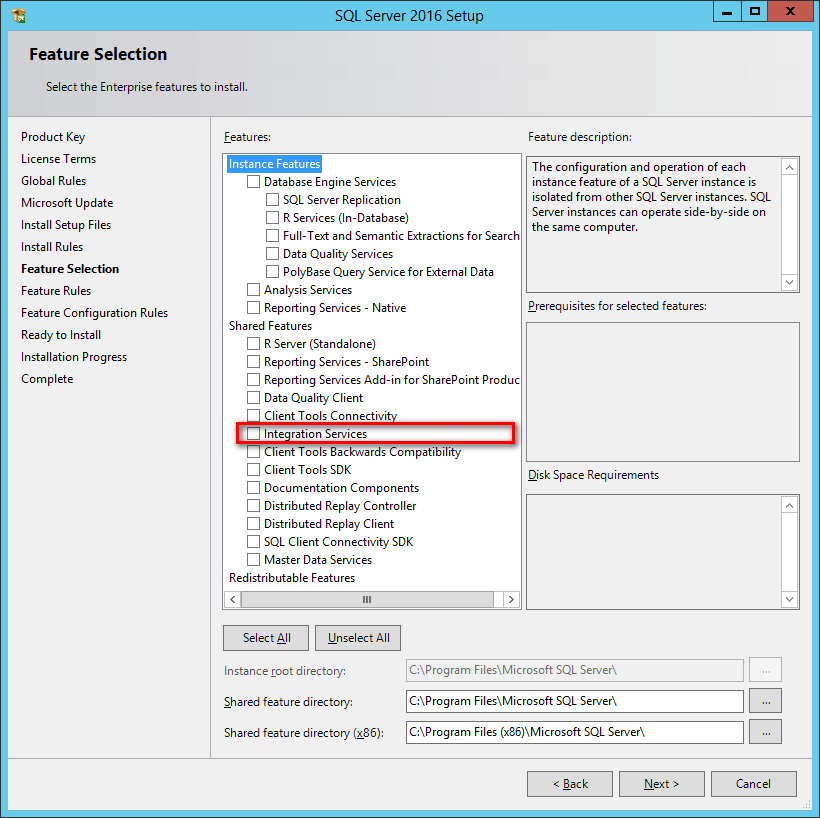
Note that when using SQL Server 2014, a cumulative update is required (a recent service pack, such as one of the following, is preferred) in order to run our software during run-time.
- SQL Server 2014 Service Pack 2: https://www.microsoft.com/download/details.aspx?id=53168
- SQL Server 2014 Service Pack 1: https://www.microsoft.com/download/details.aspx?id=46694
For SSIS design-time, you should be installing the version of SSDT (SQL Server Data Tools) or BIDS (Business Intelligence Development Studio) that aligns with the SQL Server version that you plan to use for your final deployment (the run-time).
Target Server Design Time Azure-SSIS IR Any one of the following: SSIS 2022 Any one of the following: SSIS 2019 Any one of the following: SSIS 2017 Any one of the following: SSIS 2016 Any one of the following: SSIS 2014 Any one of the following: -
SSDT for Visual Studio 2019
- Packages created using SSDT 2019 need to have their project's TargetServerVersion setting set to "SQL Server 2014" in order to work with SSIS 2014.
-
SSDT for Visual Studio 2017
- Packages created using SSDT 2017 need to have their project's TargetServerVersion setting set to "SQL Server 2014" in order to work with SSIS 2014.
-
SSDT for Visual Studio 2015
- Packages created using SSDT 2015 need to have their project's TargetServerVersion setting set to "SQL Server 2014" in order to work with SSIS 2014.
- SSDT-BI for Visual Studio 2013
-
Windows Operating System
Windows operating system requirement largely depends on the version of SSIS runtime or design-time selected. We don't have any additional requirements in terms of the Windows operating system as long as it satisfies the minimum requirements of SSIS runtime or design-time. The general guideline is the newer the operating system is, the better. In summary, our software should work for the following Windows operating systems.
-
For desktop systems (mostly for development workstations)
- We generally recommend Windows 11 or greater.
- Earlier versions of Windows desktop systems such as Windows 10, 8.1, 8, or 7 should work fine with our software, but please be mindful of the operating system support provided by Microsoft.
- We generally recommend Windows 11 or greater.
-
For server systems (mostly for runtime deployments)
- We generally recommend Windows Server 2019 or greater (including Windows Server 2022, Windows Server 2025, and potentially future Windows Server versions).
- Earlier versions of Windows Server operating systems, including Windows Server 2016, and Windows Server 2012 should work fine provided it satisfies the minimum requirements of the .NET Framework installation mentioned below. Please be mindful that those two versions are either reaching or have reached their respective extended support (also referred to as end-of-life support).
- We generally recommend Windows Server 2019 or greater (including Windows Server 2022, Windows Server 2025, and potentially future Windows Server versions).
-
For desktop systems (mostly for development workstations)
-
.NET Framework
-
- Our software requires the installation of .NET Framework 4.7.2 or above (including .NET Framework 4.8).
When you have confirmed that your system satisfies the above prerequisites, you can navigate to the KingswaySoft website at https://www.kingswaysoft.com to download the installation package.
After you have downloaded the package, you can install the software by following the installation wizard.
Working with SSIS Toolbox
SSIS Toolbox is the first place that you will be looking for our components to be added to your ETL process during the design time.
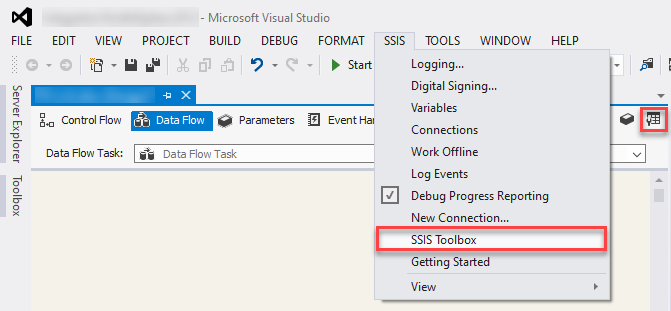
Note: When working with SSIS Toolbox, you need to make sure that you are in the right view in order to see the right components. For instance, if you are looking for a data flow component, you need to make sure that you are in the Data Flow view, not the Control Flow view. Visual Studio would show different components depending on the design view that you are currently working with.
Once the data flow components are available in the SSIS Toolbox, you can start your ETL development by dragging them from the toolbox to the Visual Studio design surface.
Using the Dynamics SL Connection Manager
SSIS Integration Toolkit for Dynamics SL includes an SSIS Connection Manager component to help you establish connections to Microsoft Dynamics SL web services.
To add a new Dynamics SL connection to your SSIS package, right-click the Connection Manager area, and choose "New Connection..." from the context menu.
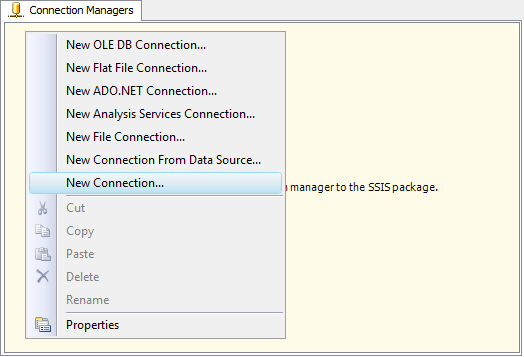
You will be prompted with the "Add SSIS Connection Manager" window, where you can select "DynamicsSL" and click "Add..." to create the connection.
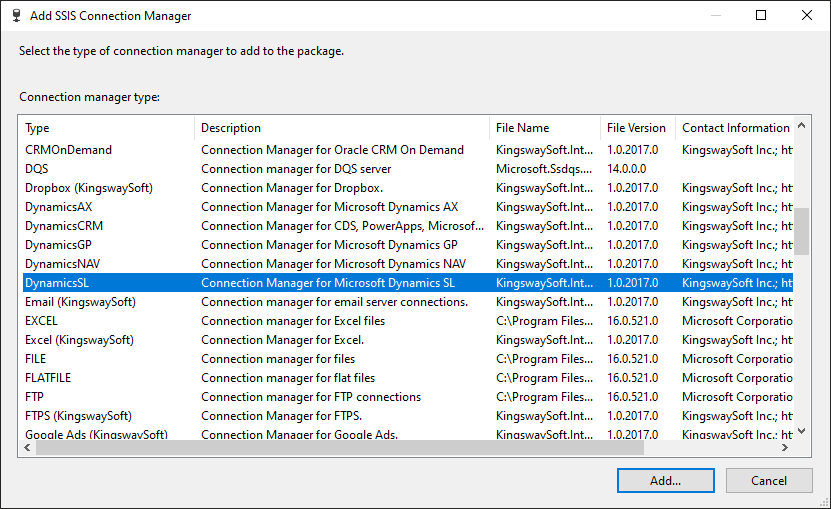
The Dynamics SL Connection Manager contains the following tabs:
- General
- Advanced Settings
- More Info
General Page
The Connection tab of the Dynamics SL Connection Manager allows you to specify connection string settings.
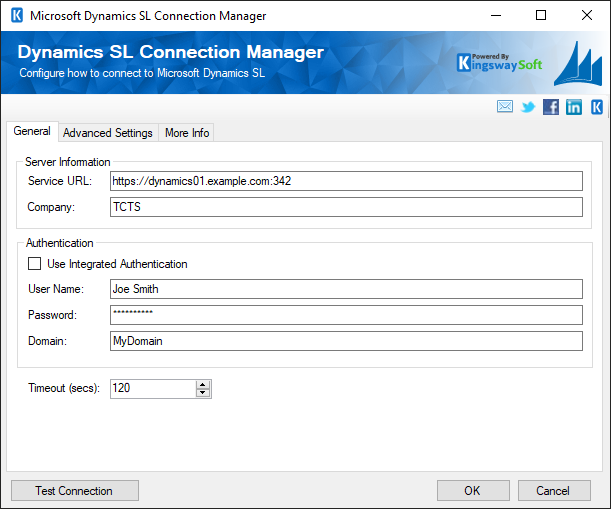
- Server Information
-
- Service URL
-
The Service URL field allows you to specify the address of where your Dynamics SL web services are located.
- Company
-
The Company field allows you to specify the company to connect to.
- Authentication
-
The authentication section allows you to specify your login credentials to the web server, whether by using a Windows account via Integrated Authentication or by specifying a User Name, Password, and Domain.
- Timeout
-
Specify the number of seconds before a web service call will Timeout.
- Test Connection
-
After all the connection information has been provided, you may click "Test Connection" to test if the user can successfully authenticate with the server.
Advanced Settings Page
The Advanced Settings tab of Dynamics SL Connection Manager allows you to specify some advanced and optional settings for the connection.
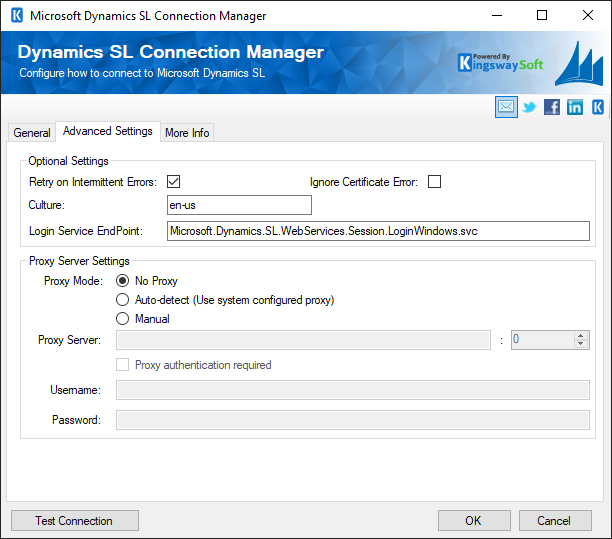
- Optional Settings
-
- Retry on Intermittent Errors
-
This is an option designed to help recover from possible intermittent outages or disruption of service. It prevents the integration process from stopping due to temporary issues. Enabling this option will allow service calls to be retried upon certain types of failure. A service call may be retried up to 3 times before an exception is fired. Retries occur after 0 seconds, 15 seconds, and 60 seconds.
Warning: We have designed our retry feature carefully such that the retry should only occur when it is deemed safe to do so; however, in some occasions, such retry service calls could result in the creation of duplicate data.
- Ignore Certificate Errors
-
This option can be used to ignore those SSL certificate errors when connecting to Dynamics SL Server, in case your SL server is using a temporary SSL certificate.
Warning: Enabling the "Ignore Certificate Errors" option is generally NOT recommended, particularly for production instances. Unless there is a strong reason to believe the connection is secure - such as the network communication is only happening in an internal infrastructure, this option should be unchecked for best security.
Note: When this option is enabled, it applies to all HTTP-based SSL connections in the same job process, it is not just limited to SL connections.
- Culture
-
The Culture setting is used as a parameter by Dynamics SL's login web service. The value defaults to 'en-us'. You may need to change this value if your Dynamics SL is configured with a different Culture setting.
- Login Service EndPoint
-
This setting points to the web service endpoint responsible for logging into Dynamics SL's web services and retrieving a valid session. You may specify the full URL or just the service endpoint name. Currently, only the LoginWindows endpoint is supported. The default value is 'Microsoft.Dynamics.SL.WebServices.Session.LoginWindows.svc'.
- Proxy Server Settings
-
- Proxy Mode
-
The Proxy Mode option allows you to specify how you want to configure the proxy server setting. There are three options available.
- No Proxy
- Auto-detect (Using system-configured proxy)
- Manual
- Proxy Server
-
Using the Proxy Server option, you can provide a proxy server to connect to the SL server.
- Port
-
The Port option allows you to specify the port number of the proxy server for the connection.
- Username (Proxy Server Authentication)
-
The Username option (under Proxy Server Authentication) allows you to specify the proxy user account.
- Password (Proxy Server Authentication)
-
The Password option (under Proxy Server Authentication) allows you to specify the proxy user's password.
Note: The Proxy Password is not included in the SL connection manager's ConnectionString property by default. This is done by design for security reasons. However, you can include it in your ConnectionString if you want to parameterize your connection manager. The format would be ProxyPassword=myProxyPassword; (make sure you have a semicolon as the last character). It can be anywhere in the ConnectionString.
More Info Page
The More Info tab shows some basic information about where to find support and additional information about the toolkit. On this page, you can find the version information of the toolkit.
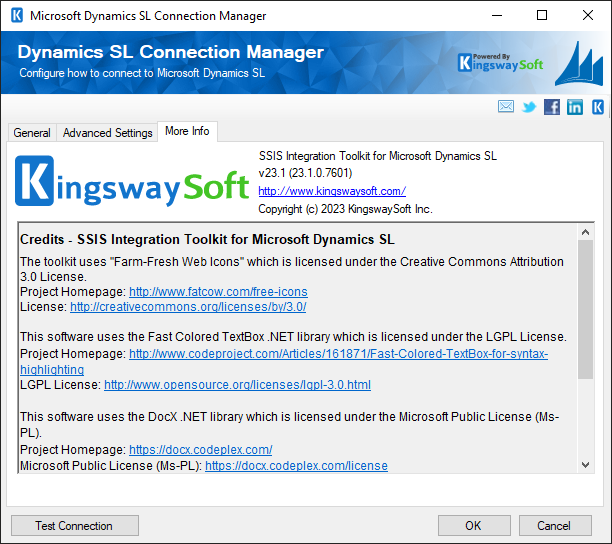
Adding SL Components to the SSIS Toolbox
Before you can use the toolkit's data flow components, they must be added to your SSIS development environment's toolbox.
If you are using SQL Server 2012 or later, you should not need to do so, as SQL Server 2012 (or a later version) automatically lists all available pipeline components by scanning the system. Under certain circumstances, your SSIS toolbox might appear empty, in which case, you should click the SSIS Toolbox button (shown below) on the top-right corner of your Control Flow or Data Flow view.
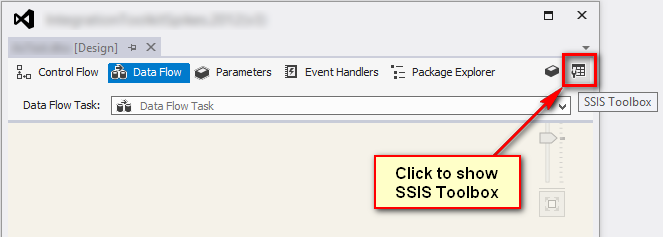
You should now be able to use the component by dragging and dropping a component to the design surface of your SSIS data flow task.
Using the Dynamics SL Source Component
The Dynamics SL Source Component allows you to read data from your SL system. The component allows you to specify a source object to read from and filter for desired records.
General Page
The General page is where you will configure most of the setup details.
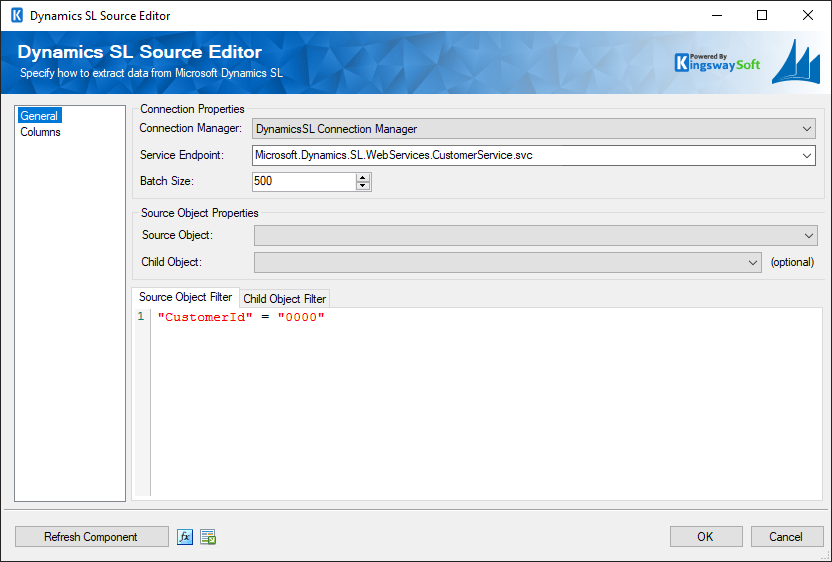
- Connection Properties
-
- Connection Manager
-
The Dynamics SL source component requires an active connection to your Dynamics SL web services. You can specify a Connection Manager here to facilitate that connectivity.
- Service Endpoint
-
Listed here are the default service endpoints provided by Dynamics SL's web services. If you have created your own web service, you must manually enter the name of your service endpoint here.
- Batch Size
-
You can configure how many records each web service call will retrieve at a time with the Batch Size setting.
- Source Object Properties
-
- Source Object
-
If a valid Service Endpoint is specified, this drop-down will list all available objects from which you can read data.
- Child Object
-
Source Objects may contain links to Child Objects. E.g. Customers (source) contain a list of Contacts (child). If you want to read data from a Child Object, choose an item from this drop-down.
Note: This is an optional setting.
- Source Object Filter
-
If you wish to filter for specific Source Object records, you can specify your filter criteria here.
The filtering syntax follows an SQL-like pattern, with fields and values encapsulated in double quotes. See examples below:
- General syntax: "MyField" = "MyValue"
- LIKE keyword: "ProjectID" LIKE "CO123%"
- AND keyword: "ProjectID" = "CO123456" AND "FiscalYear" = "2010"
- Child Object Filter
-
If you wish to filter for specific Child Object records, you can specify your filter criteria here.
- Refresh Component Button
-
Clicking the Refresh Component button causes the component to retrieve the latest metadata and update each field to its most recent metadata.
- Expression fx Icon
-
Click the blue fx icon to launch SSIS Expression Editor to enable dynamic updates of the property at run time.
- Generate Documentation Icon
-
Click the Generate Documentation icon to generate a Word document that describes the component's metadata including relevant mapping, and so on.
Columns Page
The Columns page lists all the available metadata fields for the object that you wish to read from.
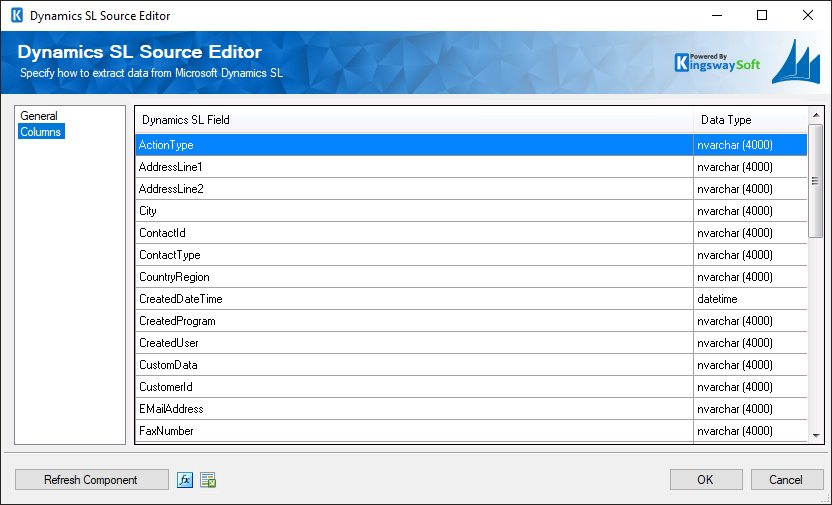
Using the Dynamics SL Destination Component
The Dynamics SL Destination Component is an SSIS data flow pipeline component that can be used to write data to Microsoft Dynamics SL. You may Create, Update, and Delete records with this component.
General Page
The General page of the Dynamics SL Destination Component allows you to specify the general settings of the component.
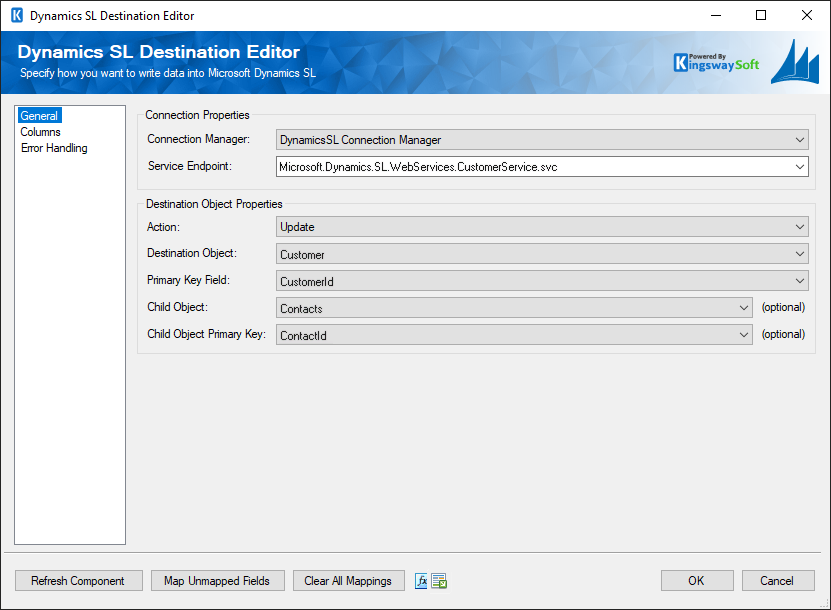
- Connection Properties
-
- Connection Manager
-
The Dynamics SL destination component requires an active connection to your Dynamics SL web services. You can specify a Connection Manager here to facilitate that connectivity.
- Service Endpoint
-
Listed here are the default service endpoints provided by Dynamics SL's web services. If you have created your own web service, you must manually enter the name of your service endpoint here.
- Destination Object Properties
-
- Action
-
The Action option allows you to specify how the data should be written into Microsoft Dynamics SL. There are three (3) action types available.
- Create: Create new record(s) in SL
- Update: Update existing record(s) in SL
- Delete: Delete record(s) from SL
- Destination Object
-
The Destination Object option allows you to specify which SL object to write data to. A drop-down with available objects is listed here.
- Primary Key Field
-
This dropdown lets you select which field corresponds to the Primary Key for the Destination Object. Currently, composite primary keys are not supported.
Note: The Primary Key field is the Destination Object's field that uniquely identifies records. Since Dynamics SL's web services do not automatically generate a unique ID for new objects, you will need to specify a source field from your upstream component that will be used to populate the primary key value in your destination.
The Primary Key field is also needed to identify which record to update or delete if those Actions are chosen.
For example, the Customer object's primary key field is the CustomerId field.
- Child Object
-
Objects may contain links to Child Objects. E.g. Customers (source) contain a list of Contacts (child). If you want to create, update, or delete data from a Child Object, choose an item from this drop-down.
Note: This is only required when you need to work with a child object. In the case that you just need to work with the parent object, you can leave this option empty.
- Child Object Primary Key
-
This drop-down lets you select which field corresponds to the Primary Key for the Child Object. Currently, composite primary keys are not supported.
Note: See the above note from Primary Key Field regarding the use of primary keys
- Refresh Component button
-
By clicking this button, the component will retrieve the latest metadata from Dynamics SL's web services. After clicking this button, you will receive a status message indicating how many fields have been updated, added, or deleted.
- Map Unmapped Fields button
-
By clicking this button, the component will map any unmapped fields by matching their names with the input columns from the upstream component. This is useful when your source component has recently added more columns, in which case you can use this button to automatically establish associations between input columns and unmapped fields.
- Clear All Mappings button
-
By clicking this button, the component will remove all field mappings. You can use this button to reset your mappings.
- Expression fx Icon
-
Click the blue fx icon to launch SSIS Expression Editor to enable dynamic updates of the property at run time.
- Generate Documentation Icon
-
Click the Generate Documentation icon to generate a Word document that describes the component's metadata including relevant mapping, and so on.
Columns Page
The Columns page of Dynamics SL Destination Component allows you to map the columns from upstream components to SL fields for the destination object.
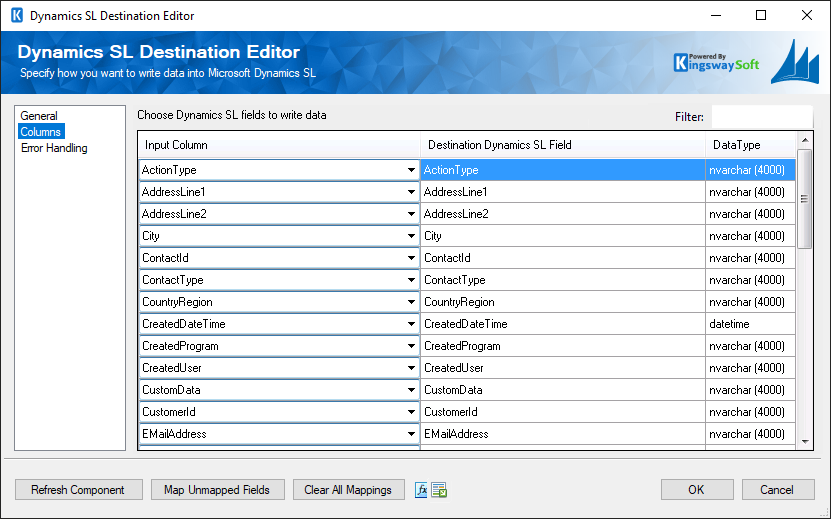
On the Columns page, you will see a grid with five columns as seen above.
- Input Column: You can select a column from your upstream component to be used as the input of the corresponding field.
- Destination Dynamics SL Field: The field that you are writing data.
- Data Type: This column indicates the type of value for the current field in Dynamics SL. Typically you would need to pass in the value using the format indicated in the Data Type column.
- Unmap: This column can be used to unmap the field from the upstream input column, or otherwise it can be used to map the field to an upstream input column by matching its name if the field is not currently mapped.
Error Handling Page
The Error Handling page allows you to specify how errors should be handled when they happen.
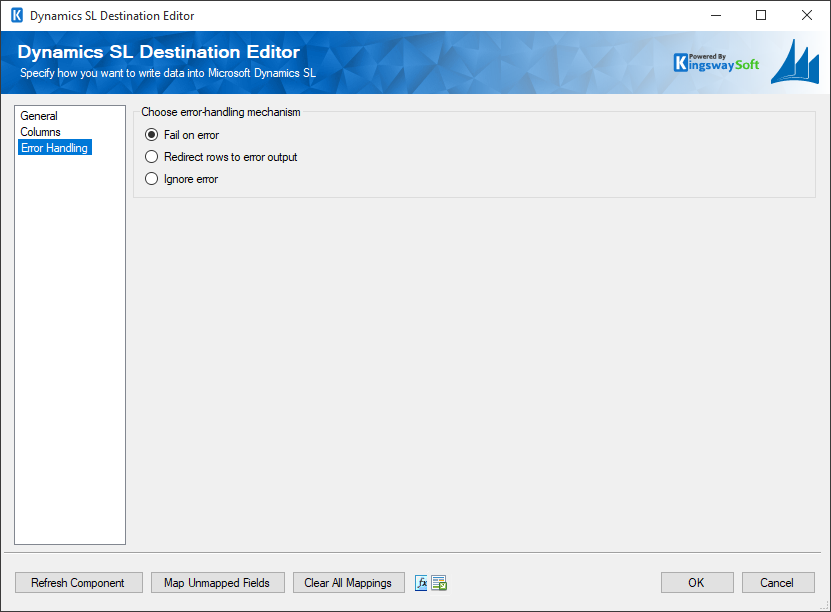
There are three options available.
- Fail on error
- Redirect rows to error output
- Ignore error
When the Redirect rows to error output option is selected, rows that failed to write to Dynamics SL will be redirected to the 'Dynamics SL Destination Error Output' output of the Destination Component. As indicated in the screenshot below, the green output connection represents rows that were successfully written, and the red 'Dynamics SL Destination Error Output' connection represents rows that were erroneous. The 'ErrorMessage' output column found in the 'Dynamics SL Destination Error Output' may contain the error message that was reported by Dynamics SL or the component itself.
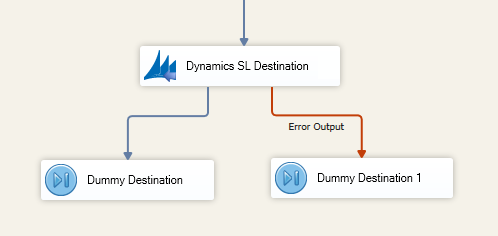
Note: Use extra caution when selecting Ignore error option, since the component will remain silent for any errors that have occurred.
License Manager
SSIS Integration Toolkit comes with a license manager program that helps you manage and activate the product license key to be used for the toolkit. The below information is useful for development workstations and Single Server license management. For Azure-SSIS IR deployments, license management and activation will be handled through the PowerShell script, see Running SSIS Integration Toolkit on the Cloud for further details.
Without a commercial license, SSIS Integration Toolkit will operate under the Developer License which is free to use for development or evaluation purposes. Under the developer license, you can use the software within the development tool (SSDT-BI, BIDS, or Visual Studio).
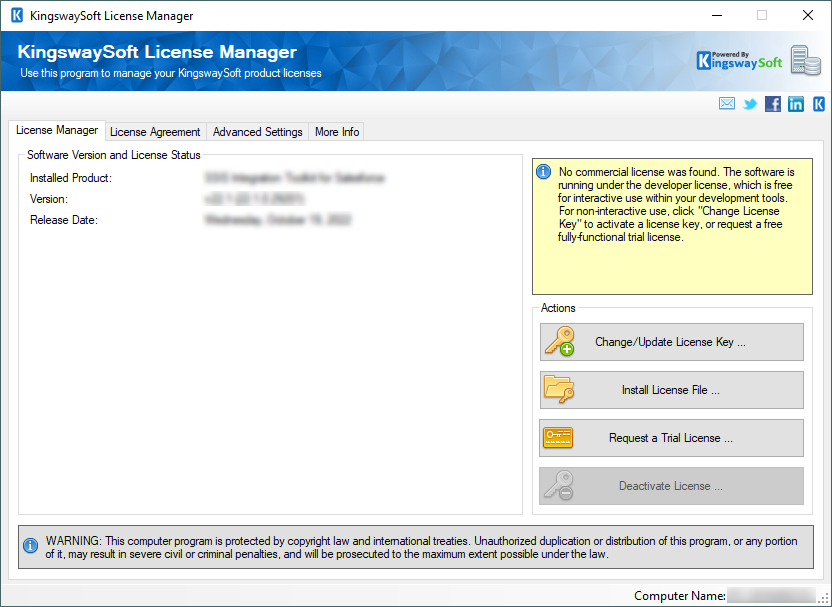
The only limitation of the free developer license is the inability to run the software outside of the development tool (SSDT-BI, BIDS, or Visual Studio). If you would like to run the software outside the development tool, such as running SSIS packages on a scheduled basis or from a command line, you will need to acquire a license from us.
If you want to test out the functionality by scheduling your SSIS packages, a trial license can be requested. To do so, you can launch the License Manager program, then click the "Change License Key" button, where you can request a free trial license after filling out the necessary Licensee Information.
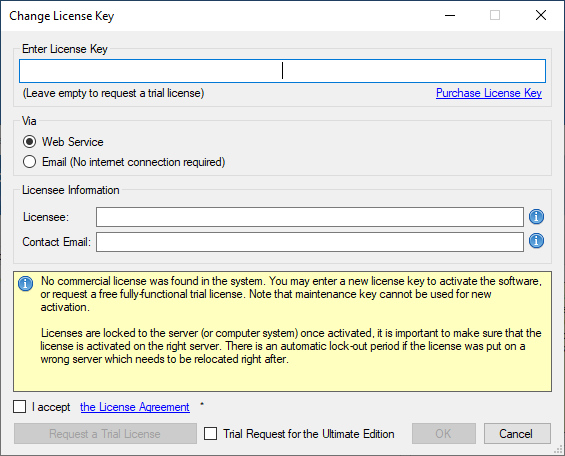
If you have received a product license key from us after placing an order through our online shopping cart system, you can also click the "Change License Key" button and enter the product license key in order to activate the software to use the fully-featured commercial license.
The Licensee field is where you will specify the company the software is licensed to, you can include your system's machine name for future reference. For example, the Licensee can be "ABC Inc." or "XYZ Corp (SQLSVR-001)." The Contact Email would be the person we reach out to for any license-related notices such as renewal reminders.
To request a free trial license or activate a product license key that you have received, you can use the Web Service option to complete the process by sending the request to our license server directly. An Internet connection is required when the Web Service option is used. This is the option that we recommend.
Alternatively, you can choose the Email option so that the license manager will generate an email for you which you can send to us. The Email option should only be used if your system has no Internet access. It requires manual processing so please expect to wait for 24 to 48 hours before receiving a license file from us. Once you have received the license file from us through email, you can save it to a local file, which you can then install by clicking the "Install License File..." button in the License Manager.
If you have acquired a license from us, once the software has been activated, your license manager will be shown as below:
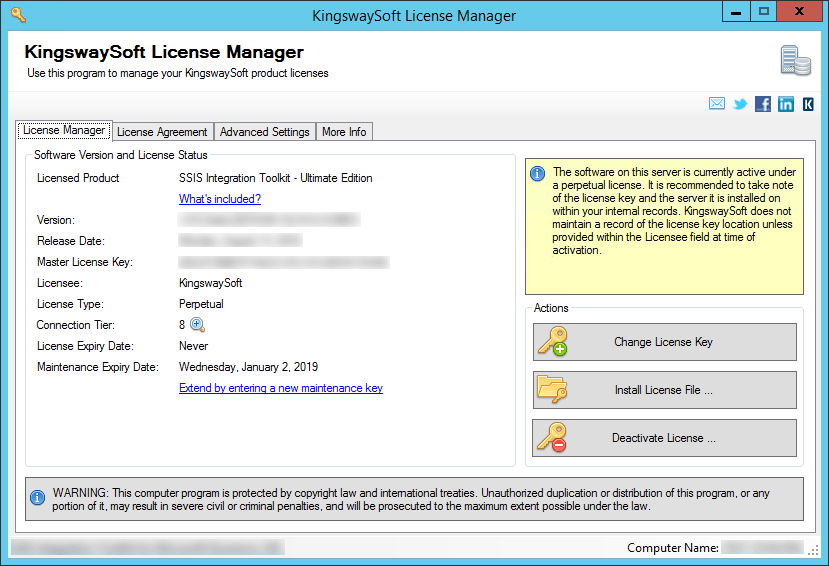
Connection Tier will display the number of distinct connections your license supports per connection type within a 24-hour period at run-time. Multiple connections to the same instance are typically treated as 1 distinct connection (exceptions may apply depending on the nature of the service). Selecting the magnify icon will launch the Run-time Connection Usage Summary window which will display counts on the number of connections made per connection type and when the 24-hour period will reset.
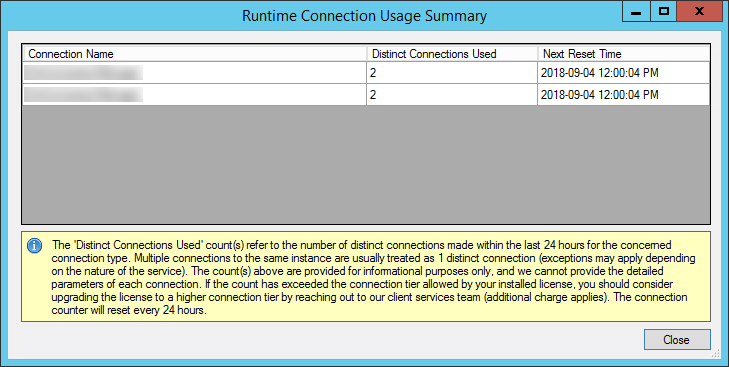
If you own a perpetual license from us, you should be able to see your Maintenance Expiry Date in the License Manager program. By default, your perpetual license should be instated with a one-year maintenance and upgrade included, which entitles you to use any version of the software released before your Maintenance Expiry Date. To extend your software license maintenance, log in to our portal and navigate to the license key using the License Keys menu. From there, you can renew the license or otherwise reach out to our Client Services team to request their assistance in renewing your license terms.
Note: Perpetual license is only applicable to clients who have previously acquired such a license before the deprecation of the license type. It is no longer offered for any new purchases.
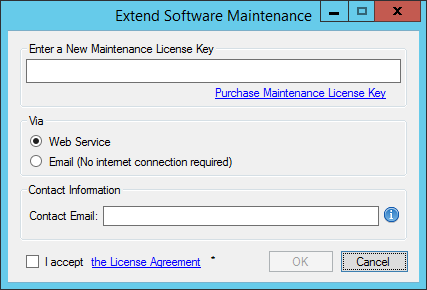
If your commercial license is a subscription license, you will not see the Maintenance Expiry Date option in the License Manager program, since your subscription license comes with maintenance and upgrade for the entire subscription period. Instead, you will see your license expiry date and a progress bar with the number of days left on your subscription.
Note: You must run the License Manager program under a local administrative account due to the privileges required to write license files to the system.
Contact Us
If you need any further assistance with the toolkit, please don't hesitate to contact us.


